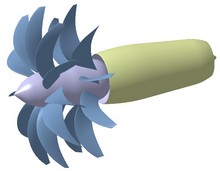Open-rotor engines are a priority under Europe's first large-scale aeronautical research programme, expected to get under way in January. Two of five engine demonstators planned under the seven-year, €1.6 billion ($2.4 billion) Clean Sky joint technology initiative (JTI) will involve open rotors.
"In the last year there has been a lot more interest in how to meet the environmental challenge when the next narrowbody comes," says Nick Peacock, who co-ordinates technology research programmes at Rolls-Royce, which will lead three of the engine demonstrators. Snecma will lead the other two.
"The Clean Sky JTI is an opportunity to build on existing European and UK research programmes and do more innovation in the architectures of the engines we test," he says. "There is a need to accelerate the exploration of open rotor, to see if its problems are solvable." As a result, open rotor demonstrators led by R-R and Snecma moved to the front of the queue, with ground tests planned for about 2012.


Open rotor options - puller (right) or pusher (left) © Snecma
Clean Sky will build on a series of engine research projects funded under the European Union's Framework Programmes (FP). These began with the R-R-led ANTLE demonstrator, a modified Trent 500 run in 2005 with the target of achieving a 12% reduction in CO2 emissions and 60% in NOx.
A second build of the ANTLE demonstrator is about to be tested under the Power Optimised Aircraft project, which is developing technology for more-electric aircraft. The engine will test an embedded starter/generator on the high-pressure spool and an active magnetic bearing on the low-pressure turbine.
The VITAL project, led by Snecma, is looking at the low-pressure system, which drives the fan. "As engines go to higher bypass ratios, we need to ensure the LP system cost and weight do not begin to dominate," Peacock says. A companion project, NEWAC led by MTU, is looking at advanced core technologies. Goals include increasing compressor pressure ratios and increasing temperatures in the core.
Intercooling
Under NEWAC, R-R is looking at intercooling - using heat exchangers to cool the air between compressors. Peacock says intercooling is particularly suited to R-R's three-shaft engines. "In a two-shaft engine there is not much of a temperature rise in the fan and booster. There is a lot more benefit to intercooling between the intermediate- and high-pressure compressors in a three-shaft engine."
Under the four-year DREAM project, part of the EU's Seventh Framework research programme which gets under way in January. R-R will lead work on a geared open rotor and Snecma on a direct-drive architecture. "DREAM will build on the accelerated interest in open rotor and study the aeroacoustics of high-speed propellers, to see if we have a chance of meeting the noise regulations," Peacock says. "It will give us an early start on understanding the technology before we commit to building an engine demonstrator."
The open-rotor demonstrator planned by R-R under Clean Sky "will be unlike anything that will see the light of day", he says. Focused on testing the propulsor, it will be much smaller than an engine that would power a narrowbody, but large enough for the results to be scalable for an Airbus or Boeing single-aisle. The baseline configuration is a geared open rotor with a counter-rotating pusher propulsor. "We plan to run the demonstrator engine by 2012, possibly earlier," says Peacock.
Snecma has begun open rotor work under a French national programme and will continue the work under the Clean Sky JTI, says Serge Eury, vice-president for research and technology. The manufacturer is also studying classical and contra-rotating turbofans as well as a range of composite materials and components to reduce engine weight.
Two of the other demonstrators planned under Clean Sky are a follow-on to R-R's Trent large three-shaft engines and a geared turbofan, led by MTU. "It is unclear quite what that will be," Peacock says. "We have deliberately negotiated a position of flexibility with the EU, as the market can be pretty fickle."
Source: Flight International
















